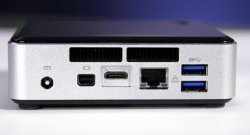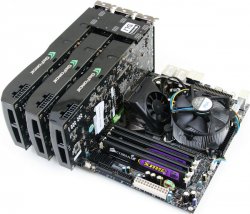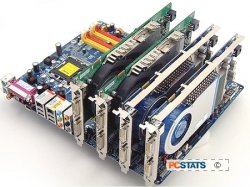I'm going to be very thorough:
Why do we require display as well as HDMI port at the back of any device say CPU/NUC i5 version ?
1. HDMI is more widespread because of its popularity for home entertainment.
2. HDMI is backwards compatible with DVI (via adapter--audio signal lost because DVI is video only).
3. HDMI 1.0 = 3.96 Gb/s, HDMI 1.3 = 8.16 Gb/s, HDMI 2.0 = 14.4 Gb/s. DisplayPort 1.0 = 8.64 Gb/s, DisplayPort 1.2 = 17.28 Gb/s, DisplayPort 1.3 = 32.4 Gb/s. As you can see, DisplayPort allows much higher bandwidth than HDMI. In layman's terms, this means higher resolution and more uncompressed audio channels.
4. DisplayPort can have multiple video and audio feeds in a single cable. Literally one cable could drive half a dozen monitors.
5. DisplayPort was created by VESA. VESA brought us DVI and VGA. Unlike HDMI, VESA has set strict requirements on quality of cable versus length of cable. Unless interference is ridiculously high, you're unlikely to encounter a cable on VGA/DVI/DisplayPort that is too long to carry the rated bandwidth. Shoddy HDMI cables (especially long ones) are liable to drop signal because there are no rules.
6. HDMI has royalties. If a device manufacturer wants to put an HDMI port on their device, they have to pay (I think) $1 per port to the alliance that made the HDMI standard. DisplayPort is free and open.
I mean to say we can even use HDMI to HDMI cable to see the display on TV or Monitor right ?
Yes. HDMI -> HDMI and DisplayPort -> DisplayPort. As long as your output device (e.g. computer) has it and your input device (e.g. monitor) does too, it should work.
If yes then why do we require Display port?
See above. To add, look at history. The entertainment industry took the computer standard for digital displays (DVI), made it compact, eliminated analog support (DVI-A), and added audio. HDMI was never intended to be used on computers but its prevalence in entertainment, ease to implement (uses existing technologies), and its small size compared to DVI made it desirable in computing as well. DVI is good for up to 2560x1600 resolutions so there was really no reason for the computing industry to improve upon DVI until we started seeing mainstream monitors with resolutions higher than DVI could handle. These computers often used two separate DVI cables so the computer saw it as two separate monitors even though it wasn't. Demand for higher resolution support was growing so VESA came up with a new standard to meet the need: DisplayPort. It's basically the best of both worlds. It has cable standards and physically hooks (so the weight of the cable won't detach it) into the device like DVI. It also has a small size and ability to carry audio like HDMI. The new feature it didn't inherit from either is the ability to support fiber optic cables as well for long distance runs. Anyway, DisplayPort is poised to replace all audio/video cable standards out there now including HDMI and DVI.
What is use of mini display port and HDMI in Intel NUC ?
Smaller plug for compact devices. Intel NUC is a tiny device so smaller ports mean they can fit more ports or make the device smaller.
Why do people use 3 graphics card in single motherboard when we can also buy a motherboard which has three display options like DVI , HDMI, Display port or VGA , DVI , HDMI or HDMI , HDMI and Display Port (Just shown in above 2nd pic of motherboard ?
More processing power for higher quality graphic settings and/or higher resolution. You don't blow that much money on graphics cards if you don't need the performance. See NVIDIA SLI and AMD Crossfire.
What I mean to say here is, if we have 3 display options at back of motherboard then by connecting three different monitors we can also open 3 different applications on it right...? If yes, then why bother about all these below multiple graphics cards...?
Applications are windowed. You can have zero windows showing on one monitor and 20 (not implying a limit here, could be unlimited) on another. That doesn't really matter. What matters is that there's enough places to plug in all of your devices and collectively, there is enough processing power in the computer to drive them all. 2D applications require hardly any performance (e.g. your internet browser). 3D applications can require a ton (even more than can be accomplished in real-time rendering).
Display Port can drive higher resolutions (like 4K) but no audio whereas HDMI can do 1080p (possibly higher depending on the HDMI spec) AND Audio depending on the drivers.
No, no, no!
VESA said:
http://www.vesa.org/wp-content/uploads/2011/01/ICCE-Presentation-on-VESA-DisplayPort.pdf page 36
AUX can be used to transport auxiliary data, such as:
– Camera and Microphone A/V data from Sink to Source for teleconferencing
– Fast AUX mode can be used for USB 2.0 data to support USB hub in Display
(cable consolidation)
AUX channel can effectively be a bi-directional USB 2.0 cable which means all USB devices could work through it including mice, keyboards, cameras, microphones, printers, scanners, and memory sticks.
DisplayPort also supports all kind of digital audio including 8 channel PCM, DRA, Dolby MAT, DTS HD, and even protected audio.
Think of DisplayPort as a really high bandwidth cable because that's effectively what it is.













